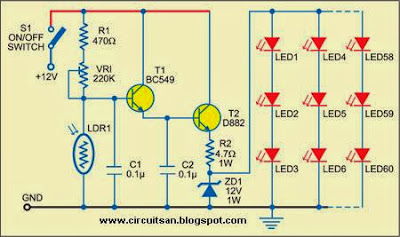Multiple Applications of High Power LEDs
Friday, September 19, 2014 | Labels: applications, high, leds, multiple, of, power | |
Nowadays, high-power light-emitting diodes (LEDs) LXHLMW1C are available in the market. These white LEDs contain indium-gallium-nitrogen (InGaN). The LEDs’ emitting capacity is 20 candela (Cd). We can use these LEDs for automatic garden lighting and wide voltage operation by applying different voltages.

Fig. 1: Circuit for automatic garden lighting
Fig. 1 shows the circuit for automatic garden lighting. Switch S1 connects 12V to the circuit built around transistors T1 and T2. Light-dependent resistor LDR1 is used to sense the light intensity and preset VR1 is used to adjust the threshold of light. The resistance of LDR remains low in daylight and high at night (in darkness).
In the morning, light falls on LDR1 and transistors T1 and T2 are cut-off. As a result, 12V supply is not available to the LEDs. In the evening, when no light falls on LDR1, transistors T1 and T2 conduct to provide 12V to the LEDs. This turns on all the LEDs (LED1 through LED60). The on/off switching level can be adjusted by 220 kilo-ohm preset according to the intensity of the light.
The emitting capacity of LEDs (UW-510CWH) used here is 8 Cd. Since a total of 60 of these LEDs have been used, this unit will provide luminous intensity equivalent of 480 Cd. The LEDs are arranged in twenty rows, with each row having three LEDs in series. The input voltage is approximately 12V and all the LEDs are spaced 1 to 1.5 cm apart.

Fig. 2: Circuit for wide-voltage operation
You can use the switching section for other systems as well. You just need to remove the LED section from the circuit and connect the switching section to the desired system. So the system will now automatically switch on in the evening and switch off in the morning.

Fig. 3: Pin configuration
Fig. 3 shows pin configuration of regulator LM317 and transistors D882 and BC549. Use heat-sinks in regulator LM317 and transistor D882 before soldering them onto the PCB.


Post a Comment
Note: Only a member of this blog may post a comment.